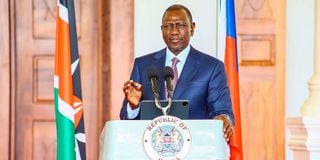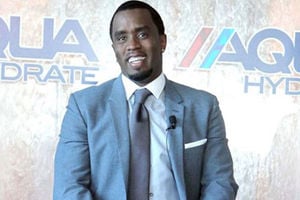
President William Ruto.
On April 22, 2013, the eastern steps of State House, Nairobi, served as the stage for what seemed like the dawn of a new political era. Uhuru Kenyatta and William Ruto, dressed in matching attire, stepped out with an air of camaraderie that hadn’t been seen in Kenya’s highest office for years.
The media quickly latched onto the optics, marvelling at the apparent chemistry between the President and his deputy. It felt like, at last, Kenya had a leadership duo that wasn’t just a formal pairing but a true political partnership.
And that was the much they offered, then: optics. The honeymoon would soon be over.
President Kenyatta harboured unwavering faith in Deputy President Ruto, yet their personal dynamics were marked by stark contrasts: While Ruto is a teetotaller, President Kenyatta loved his tipple. On the other hand, Ruto had an insatiable appetite for wealth, power and influence. At every corner, he was always eager to seize opportunities as they arose. His ambition, to be a wealthy oligarch, often manifested as a restless energy, driving him to act decisively and, at times, impulsively. This approach made him a formidable player in the political arena.
Ruto was the first Deputy President under the new Constitution and his position was not held under the mercy of the President, unlike the previous holders. This gave him a chance to outmanoeuvre his boss.
During Kenyatta’s first term, he appeared more figurehead than leader, eclipsed by elected officials who dominated the political arena. Governors, emboldened by devolution, outshone County Commissioners, while Cabinet appointees found their influence diminished.
County governors , now addressed as “Your Excellency,” a title once reserved for the presidency, wielded unprecedented authority, overshadowing technocrats and provincial administrators alike. Even Uhuru, despite his position, seemed to fade in Ruto’s imposing shadow.
The two had a history. As President Moi’s departure loomed on the horizon, Ruto had emerged as one of the few ‘young turks’ hand-picked by State House to champion Uhuru’s ascent as Moi’s chosen successor.
Already, Ruto had made a name for himself, gaining notoriety as a shrewd and fiery agitator. His push for the redistribution of the 4,000-acre farm belonging to the East African Tanning and Extract Company (EATEC) won him widespread praise in Nandi District. More so, Moi brought him back to the centre, rescuing him from United Democratic Movement (UDM) the formation he had with Cyrus Jirongo—his former chairman in the Youth for Kanu ‘92 movement—Kipruto arap Kirwa, and Fred Amayo. By siding with Uhuru under the Kanu banner as others fled, the two were bound by history and shared problems.
Close confidants recall that any who dared cast aspersions upon Ruto during Uhuru’s first term were swiftly consigned to the shadows. When the President was provoked, his rebukes were cutting and unforgiving, leaving little room for dissent. In this climate, Kenyatta’s inner circle wisely embraced silence as a shield, safeguarding their fragile standing.
Ruto, ever the master strategist, thrived in this atmosphere. With deft precision, he turned the stillness into an arena for his own ascendancy, methodically dismantling his critics—most of whom hailed from Kenyatta’s Mt Kenya stronghold. In a bold power play, he reshaped the region’s political landscape to suit his ambitions, installing loyalists in key positions and manipulating the faithful with the ease of a puppet master pulling invisible strings. Under Ruto’s calculated influence, the mountain’s political winds began to shift, blowing in his favour as his critics fell one by one, leaving a kingdom forged in silence and power.
Uhuru and Ruto’s alliance was born not out of friendship, but out of survival. In the opulent surroundings of Jimi Wanjigi’s Muthaiga residence, both men, entangled in charges at the International Criminal Court and running under different party banners, faced a pivotal challenge from Wanjigi: unite or risk political annihilation. This forced marriage effectively sidelined Kalonzo Musyoka, the then-retiring Vice President under Mwai Kibaki, who was none too pleased with the turn of events.
In his autobiography, Kalonzo captures the moment with clarity: “That night, Jimi, Uhuru, and Ruto drove to see me. As we walked down to the gazebo for dinner, Ruto and Jimmy sat silently, while Uhuru took the lead. ‘Stephen,’ he said, ‘We have decided that you should choose another position, but not the presidency or the deputy presidency.’ I was stunned. I had no idea when or how the arrangement we had earlier made, which had placed me on the presidential ticket, had been altered.”
Read: The Ruto you never knew
Following that fateful meeting, Kalonzo bolted into the camp of Raila Odinga, and together they faced defeat in the 2013 election against the formidable Jubilee Coalition, a union of Uhuru’s The National Alliance (TNA) and Ruto’s United Republican Party (URP).
Under this new arrangement, Ruto was promised control over half of the government, giving him a semblance of muscle that his predecessors had lacked. However, the Jubilee Coalition’s grand promises—from stadiums and laptops to free education—quickly spiralled into avenues of sleaze and corruption.
The first term of the Uhuru-Ruto administration unfolded like a grand tapestry, intricately woven with scandals and grandiose mega-projects—some, like the illusory Arror and Kimwarer dams, bloomed only in the fertile soils of the nation’s collective imagination. Together, the duo clasped hands in defence of questionable deals, their unity seemingly cemented by controversy they shared.
On June 25, 2014, President Kenyatta addressed the nation from the stately confines of State House, Nairobi, with a proclamation: Kenya was to receive an initial Sh174 billion, part of a grand Sh250 billion sovereign bond. Yet, in time, murmurs would arise, questions echoing through the corridors of power—where, exactly, had this colossal sum vanished? By the 2015 Jamhuri Day celebrations, President Kenyatta issued a stern warning: “If you make accusations and fail to prove them, you too will also be held accountable.” Meanwhile, his deputy, ever dismissive, branded allegations of Eurobond misuse as “utter nonsense,” casting off criticism with characteristic bravado.
Kenyatta, wary of alienating his deputy, whose political clout stemmed from the vast electorate of the Rift Valley, trod carefully. This was a manoeuvre unlike any attempted by previous deputy presidents. Moreover, both men were ensnared in the relentless grasp of their ICC cases, bound together like Siamese twins in a shared struggle for survival. Rumours swirled that their supporters had rallied behind them not merely for political aspirations but in a desperate bid to shield them from the clutches of the International Criminal Court. In this intricate dance of power and survival, the stakes had never been higher, nor the alliances more fragile.
While the taint of scandals was shared equally, the stench was selectively channelled. But this bromance would end as the ICC cases collapsed and the reality dawned on both that time was running out.
Once President Kenyatta had secured his second term, he turned his focus toward shaping a lasting legacy. Meanwhile, Ruto wasted no time, launching his own political campaigns and building a robust network, particularly through religious platforms, to court public favour. With his re-election behind him, Uhuru, no longer tethered by the need for political survival, unleashed the full might of the state’s administrative and security machinery, targeting the corrupt system of patronage, hand-outs, and illicit networks that had thrived unchecked. His war on graft, money laundering, counterfeit goods, and transnational crimes signalled the beginning of an all-out offensive against a deeply entrenched political order. As Uhuru dismantled these corrupt networks, Ruto and his allies cried foul, framing the President’s moves as politically motivated and designed to marginalize his supporters and curtail his ambitions.
Handshake
It wasn’t long, however, before a new dynamic emerged within the corridors of power: Raila Odinga, once Kenyatta’s staunch rival, entered into a historic ‘handshake’ with the president, forever altering the political landscape. In the aftermath, the once close partnership between Kenyatta and Ruto slipped into irrelevance, with the Deputy President’s office quietly retreating to the background, its influence diminished to a distant memory.
His allies faced the wrath of the Directorate of Criminal Investigations and records indicated that there was a web of scandals where public coffers were easily raided. Ruto was always in their defence and sold the narrative that the DCI was used as a weapon against him. As Uhuru tried to push for Odinga’s candidacy, the previous calm restraint collapsed and, within Mt Kenya, Ruto’s strategy was to damage Uhuru’s reputation and sell Railaphobia. It worked as propaganda against Uhuru and Raila – as dynasties - won the day.
When the government tried to go for Ruto’s Weston Hotel, built on public land, he, and his propaganda machine, cried foul. There were many other battles for the control of Jubilee Party. Finally, Ruto decamped to a new outfit, UDA, which was an assembly of all those who had fallen out with Uhuru.
The campaigns were brutal. For the first time, a DP and the President were exchanging words in public and the President had no powers to act. With the churches safely within his reach, Ruto characterised Odinga as a non-believer. It was only a matter of time. Odinga had underestimated Ruto’s might and thought that the powerful “deep state” would guarantee him votes. When the final tally was announced, Ruto orchestrated a resounding victory. Raila Odinga was left in disbelief, stunned by the outcome.
On the day of his swearing-in, Ruto handed the microphone to his deputy, Rigathi Gachagua, for a final, stinging blow. Gachagua took the moment to publicly humiliate Uhuru before a gathering of dignitaries, leaving the former head of state chastened. Gachagua, emboldened by the spectacle, perhaps believed that his newfound “bromance” with President Ruto would endure—but the future of such alliances, like all things in politics, remained uncertain.
Tomorrow: Rigathi Gachagua’s decent from the summit
In case you missed it, here are the other captivating stories on the curse of the deputies.








